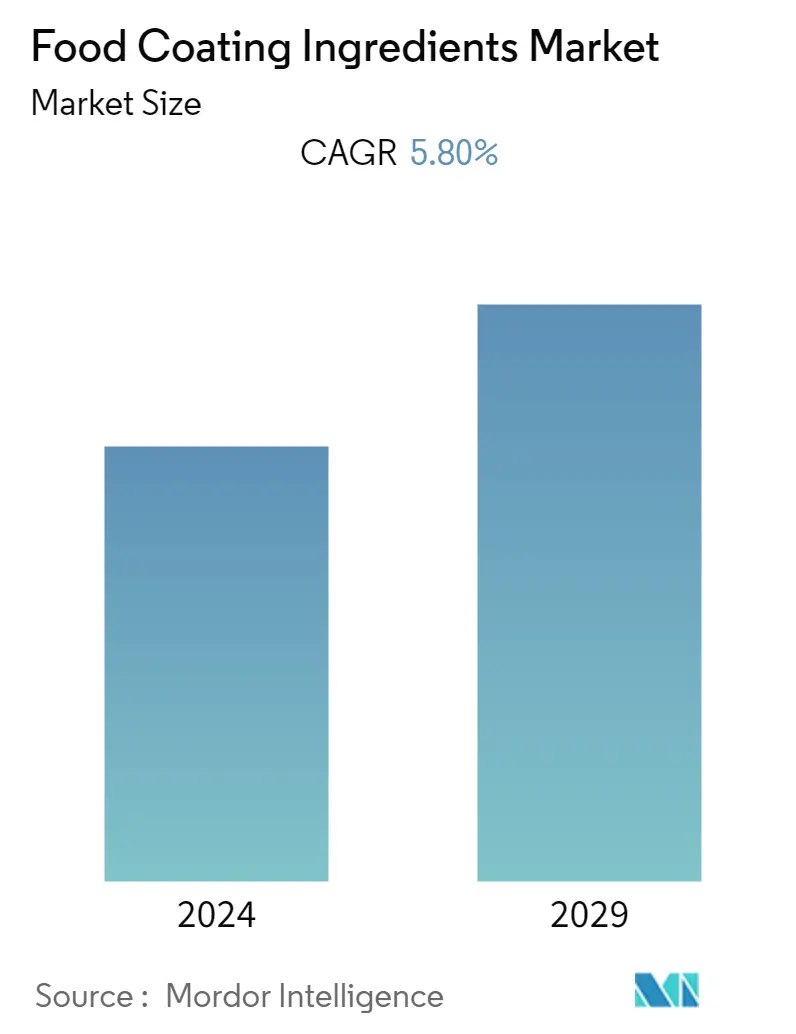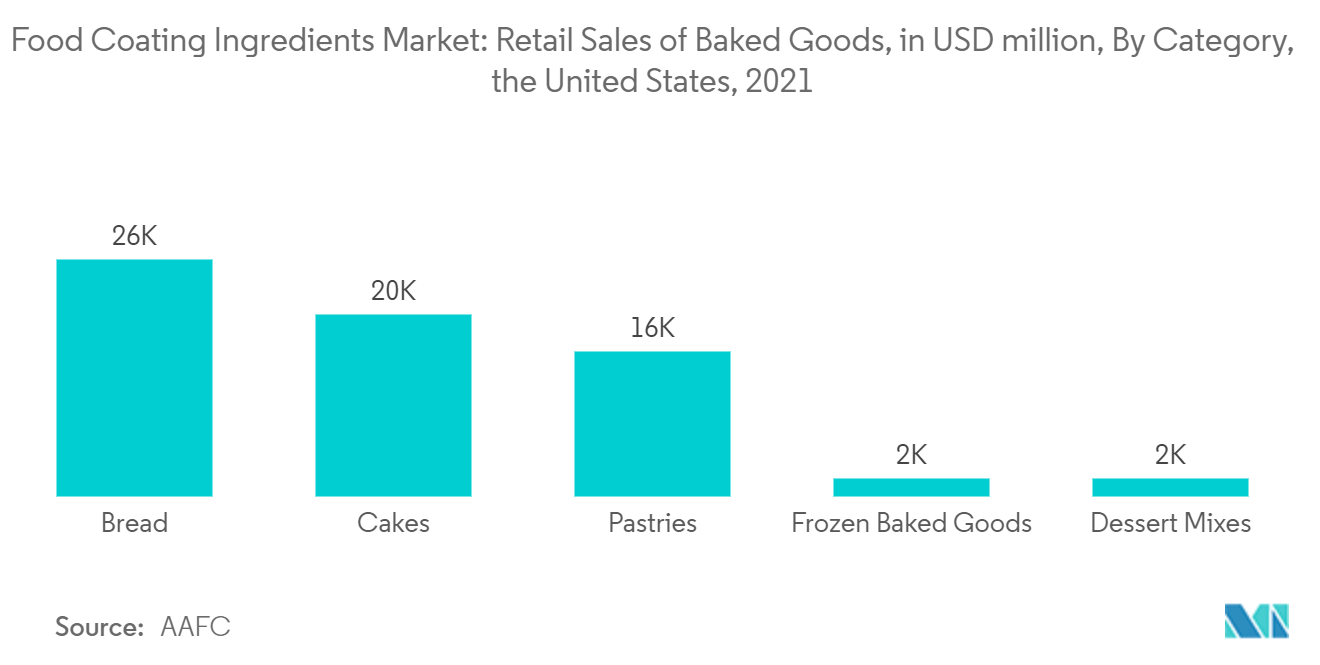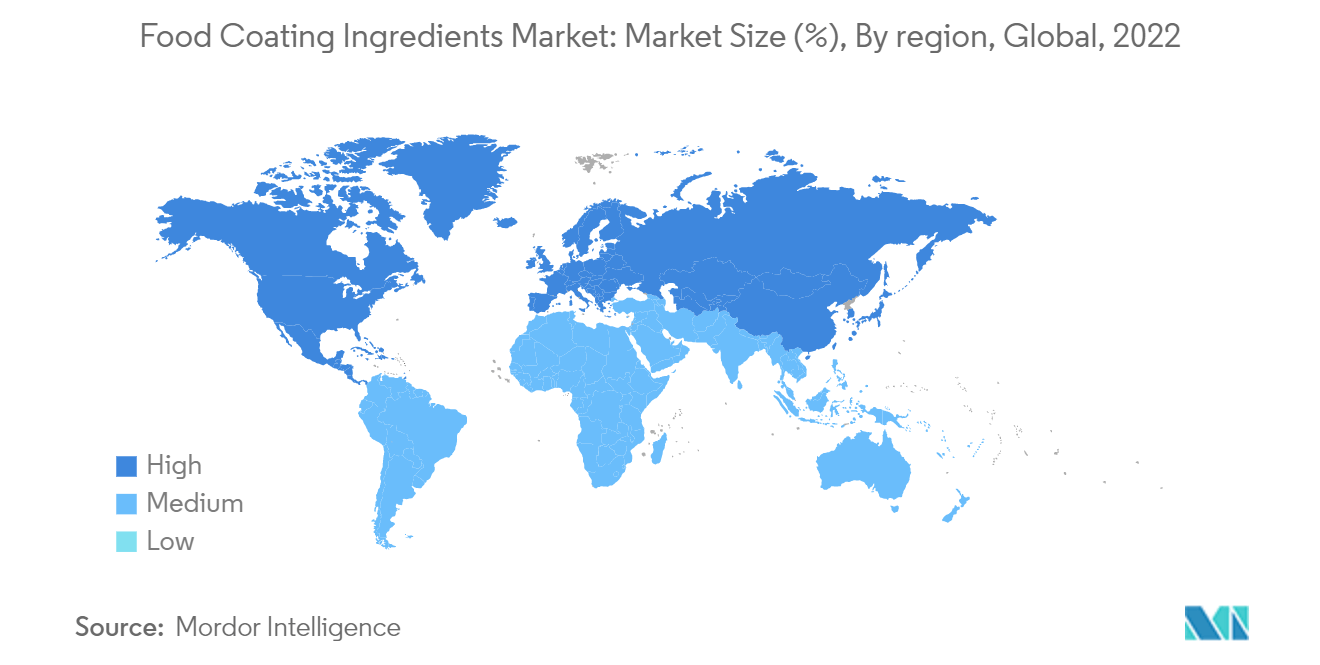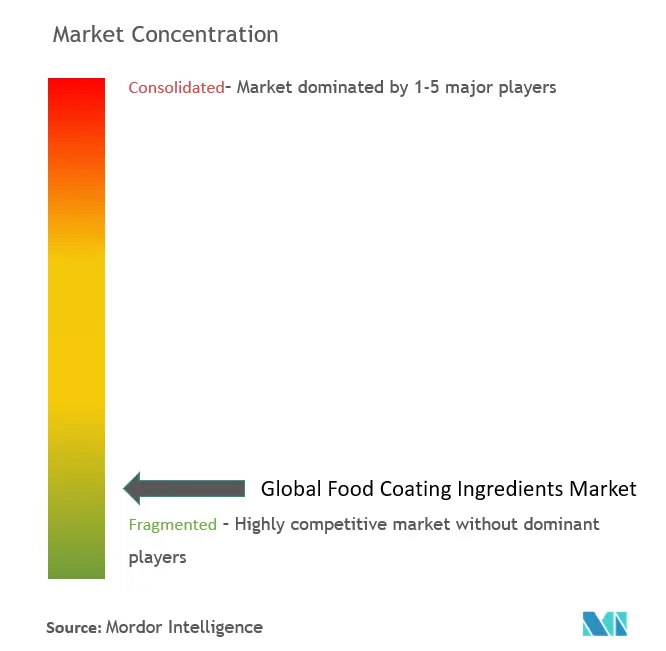Food Coating Ingredients Market Size

| Study Period | 2019 - 2029 |
| Base Year For Estimation | 2023 |
| CAGR | 5.80 % |
| Fastest Growing Market | Asia Pacific |
| Largest Market | North America |
| Market Concentration | High |
Major Players.webp)
*Disclaimer: Major Players sorted in no particular order |
Food Coating Ingredients Market Analysis
The Food Coating Ingredients Market is projected to witness a CAGR of 5.8% over the next five years.
Food coating is an instantaneous application of ingredients in nourishment handling and controls improvement strategy. The market is mainly driven by the increasing demand from industrial food applications, especially confectionery, bakery, fried foods, and ready-to-eat foods, contributing towards color, taste, and sweetness attributes to the food product being coated. For instance, according to Snack Food and Wholesale e-magazine, the sales of center store bread in the United States were approximately USD 9.11 billion this year.
Additionally, edible coating and films have received considerable attention from consumers for their apparent advantages (such as edible and eco-friendly nature) over synthetic films. Polysaccharides, lipids, and protein-based materials are used for edible packaging for bakery products. The most significant function of edible packaging is its use as a carrier of nutrients to increase the nutritional value of final processed food products. With the growing trend of edible packaging, manufacturers are focused on producing innovative packaging to gain a consumer base.
However, stringent rules and regulations regarding clean-label coating ingredients laid down by government bodies are hampering the growth of the market. For instance, the FDA and European Commission have prevented the usage of synthetic colors as coatings in the F&B industry in the United States on the basis of claims of carcinogenicity, on the basis of the Delaney Clause, although it is still used in the European Union as later evaluations by JECFA and the EFSA concluded their use is safe. Also, the high calorific values of certain indulgent coating ingredients restrain the market growth.
Food Coating Ingredients Market Trends
Increased Consumption of Bakery and Confectionery Products
The consumption of confectioneries and bakery products, such as wafer bars, pastries, bread, and cookies, has increased significantly in recent years owing to the demand arising from children, especially chocolate-coated products. For instance, according to the Government of Canada, last year, Canada saw recorded retail sales of USD 6.6 billion worth of baked goods and is expected to reach USD 7.8 billion by 2026. These coatings, apart from improving the flavor and texture, extend the shelf-life of the product by acting as a barrier to moisture loss.
Additionally, the traditional process of enrobing was slow and involved manually dipping; however, increased demand for these products has opened room for many technologically advanced techniques, such as electrostatic coating, therefore, enhancing the production rate and meeting the demand of the consumers.
Furthermore, bakery and confectionery products claiming to contain natural and organic ingredients have witnessed increased demand, and this concept has been evolving across other markets as well, including food coating ingredients. Product launches with various label claims, such as no artificial additives, no preservatives, non-GMO, and reduced sugar, are becoming increasingly popular. Thereby, the increased consumer demand for nutritious products and the rising clean-label claims on products have accelerated market growth. For instance, in May 2022, Blommer Chocolate Co. and DouxMatok introduced coatings in collaboration with Incredo Sugar to reduce sugar in a variety of food processing steps like panning, enrobing, and molding. According to the companies, no high-intensity sweeteners or polyols were used in the creation of the new line of milk, dark, and white coatings, and sugar content has been cut by up to 50% (sugar alcohols). With these components, Chicago-based Blommer claims it can reduce sugar content in products like nut butter cups, bars, and chocolate chip cookies by more than 40%.

Asia-Pacific is the Fastest-growing Region
In the Asia-Pacific region, India and China specifically are the fastest-growing region due to the robust demand for confectionery and bakery industries, along with the growing popularity of ready meals and convenience foods among the working population has propelled the growth of the market. According to the United States Department of Agriculture (Foreign Agriculture Service), the sales value of ready meals in India last year was USD 172.6 million.
Additionally. according to the United States Department of Agriculture, the edible coatings ingredients like protein or polysaccharides can keep fruits and vegetables fresh for up to a month in the fridge without their going soft, losing weight, or picking up any harmful bacteria and minimize the amount and cost of packaging and related packaging waste. Thus, ready-to-eat food has gone a long way since its introduction in the form of instant noodles, soup, frozen vegetables, and frozen snacks, which significantly utilize food coatings for the preservation of taste, flavor, and texture.
Furthermore, the bakery products market is experiencing significant growth as players operating in the market continuously differentiate their offerings in terms of ingredients, flavors, and composition. Also, there is an influence of Western flavors and culture in some Asian countries, where consumers are increasingly seeking convenient foods, which presents opportunities for the food coating ingredients for these growing industries.

Food Coating Ingredients Industry Overview
The food coating ingredients is a fragmented market, with the leading companies driving the growth. Investments and expansions formed the most preferred strategy among the key players to attract and retain new customers globally. The players in the market use various corporate strategies like product innovations to cater to the needs of the consumers. For example, manufacturers are introducing various clean-label, gluten-free, and even uniquely flavored bakery products to increase their consumer base.
Food Coating Ingredients Market Leaders
-
Cargill, Incorporated
-
Archer Daniels Midland Company
-
Associated British Foods PLC
-
Agrana Beteiligungs-Ag
-
Pioneer Food Group
*Disclaimer: Major Players sorted in no particular order

Food Coating Ingredients Market News
- Oct 2022: Puratos India launched colored and flavored compound and compound filling in two categories, including Hard Compound Chocolate- Carat Cover Classic and Fat-based filling- Carat Supercrem. According to the company, the product is used to provide flavor and color to the finished products without the complexity of ingredient sourcing.
- May 2022: Blommer Chocolate Co. and DouxMatok introduced coatings in collaboration made with Incredo sugar to reduce sugar in a variety of food processing steps like panning, enrobing, and molding. According to the companies, no high-intensity sweeteners or polyols were used in the creation of the new line of milk, dark, and white coatings, and sugar content has been cut by up to 50% (sugar alcohols). With these components, Chicago-based Blommer claims it can reduce sugar content in products like nut butter cups, bars, and chocolate chip cookies by more than 40%.
- Nov 2021: Sufresca, an Israel-based Agtech company, launched an invisible edible coating for shelf life extension that has been applied to a wider variety of fresh vegetables. According to the company, the newly developed edible coating has been shown to function very well on a wide variety of tomatoes, in particular cherry tomatoes, cucumbers, and even fruits like mangoes, to increase their shelf-life.
Food Coating Ingredients Market Report - Table of Contents
1. INTRODUCTION
1.1 Study Assumptions and Market Definition
1.2 Scope of the Study
2. RESEARCH METHODOLOGY
3. EXECUTIVE SUMMARY
4. MARKET DYNAMICS
4.1 Market Drivers
4.2 Market Restraints
4.3 Porter's Five Forces Analysis
4.3.1 Threat of New Entrants
4.3.2 Bargaining Power of Buyers/Consumers
4.3.3 Bargaining Power of Suppliers
4.3.4 Threat of Substitute Products
4.3.5 Intensity of Competitive Rivalry
5. MARKET SEGMENTATION
5.1 Type
5.1.1 Sugars and Syrups
5.1.2 Cocoa and Chocolates
5.1.3 Fats and Oils
5.1.4 Spices and Seasonings
5.1.5 Flours
5.1.6 Batter and Crumbs
5.1.7 Others
5.2 Application
5.2.1 Bakery
5.2.2 Confectionery
5.2.3 Breakfast Cereals
5.2.4 Snack
5.2.5 Dairy
5.2.6 Meat
5.2.7 Others
5.3 Geography
5.3.1 North America
5.3.1.1 United States
5.3.1.2 Canada
5.3.1.3 Mexico
5.3.1.4 Rest of North America
5.3.2 Europe
5.3.2.1 Spain
5.3.2.2 United Kingdom
5.3.2.3 Germany
5.3.2.4 France
5.3.2.5 Italy
5.3.2.6 Russia
5.3.2.7 Rest of Europe
5.3.3 Asia Pacific
5.3.3.1 China
5.3.3.2 Japan
5.3.3.3 India
5.3.3.4 Australia
5.3.3.5 Rest of Asia-Pacific
5.3.4 South America
5.3.4.1 Brazil
5.3.4.2 Argentina
5.3.4.3 Rest of South America
5.3.5 Middle East and Africa
5.3.5.1 South Africa
5.3.5.2 United Arab Emirates
5.3.5.3 Rest of Middle East and Africa
6. COMPETITIVE LANDSCAPE
6.1 Most Adopted Strategies
6.2 Market Share Analysis
6.3 Company Profiles
6.3.1 Cargill Inc.
6.3.2 Archer Daniels Midland Company
6.3.3 Associated British Foods PLC
6.3.4 Agrana Beteiligungs-Ag
6.3.5 Pioneer Foods
6.3.6 Cooperatie AVEBE U.A.
6.3.7 Ingredion Incorporated
6.3.8 Tate & Lyle PLC
6.3.9 Kerry Group PLC
- *List Not Exhaustive
7. MARKET OPPORTUNITIES AND FUTURE TRENDS
Food Coating Ingredients Industry Segmentation
Food Coatings are the ingredients used to coat food to add texture, flavor, and nutritional value.
The Food Coating Ingredients Market is segmented by Type (Sugars and Syrups, Cocoa and Chocolates, Fats and Oils, Spices and Seasonings, Flours, Batter and Crumbs, and Other Types), Application (Bakery, Confectionery, Snacks, Dairy, Meat, and Other Applications), and Geography (North America, Europe, Asia-Pacific, South America, and Middle-East and Africa). The market sizing has been done in value terms in USD for all the abovementioned segments.
| Type | |
| Sugars and Syrups | |
| Cocoa and Chocolates | |
| Fats and Oils | |
| Spices and Seasonings | |
| Flours | |
| Batter and Crumbs | |
| Others |
| Application | |
| Bakery | |
| Confectionery | |
| Breakfast Cereals | |
| Snack | |
| Dairy | |
| Meat | |
| Others |
| Geography | |||||||||
| |||||||||
| |||||||||
| |||||||||
| |||||||||
|
Food Coating Ingredients Market Research FAQs
What is the current Food Coating Ingredients Market size?
The Food Coating Ingredients Market is projected to register a CAGR of 5.80% during the forecast period (2024-2029)
Who are the key players in Food Coating Ingredients Market?
Cargill, Incorporated, Archer Daniels Midland Company, Associated British Foods PLC, Agrana Beteiligungs-Ag and Pioneer Food Group are the major companies operating in the Food Coating Ingredients Market.
Which is the fastest growing region in Food Coating Ingredients Market?
Asia Pacific is estimated to grow at the highest CAGR over the forecast period (2024-2029).
Which region has the biggest share in Food Coating Ingredients Market?
In 2024, the North America accounts for the largest market share in Food Coating Ingredients Market.
What years does this Food Coating Ingredients Market cover?
The report covers the Food Coating Ingredients Market historical market size for years: 2019, 2020, 2021, 2022 and 2023. The report also forecasts the Food Coating Ingredients Market size for years: 2024, 2025, 2026, 2027, 2028 and 2029.
Food Coating Industry Report
Statistics for the 2024 Food Coating market share, size and revenue growth rate, created by Mordor Intelligence™ Industry Reports. Food Coating analysis includes a market forecast outlook to 2029 and historical overview. Get a sample of this industry analysis as a free report PDF download.



